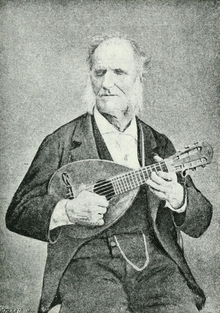
A mandolin is a stringed musical instrument in the lute family and is generally plucked with a pick. It most commonly has four courses of doubled strings tuned in unison, thus giving a total of eight strings. A variety of string types are used, with steel strings being the most common and usually the least expensive. The courses are typically tuned in an interval of perfect fifths, with the same tuning as a violin. Also, like the violin, it is the soprano member of a family that includes the mandola, octave mandolin, mandocello and mandobass.

Giovanni Bottesini was an Italian Romantic composer, conductor, and a double bass virtuoso.

Crema is a city and comune in the province of Cremona, in the region of Lombardy in northern Italy. It is built along the river Serio at 43 km (27 mi) from Cremona. It is also the seat of the Catholic Bishop of Crema, who gave the title of city to Crema.
Carlo Cecere was an Italian composer of operas, concertos and instrumental duets including, for example, some mandolin duets and a concerto for mandolin. Cecere worked in the transitional period between the Baroque and Classical eras.

The mandore is a musical instrument, a small member of the lute family, teardrop shaped, with four to six courses of gut strings and pitched in the treble range. Considered a French instrument, with much of the surviving music coming from France, it was used across "Northern Europe" including Germany and Scotland. Although it went out of style, the French instrument has been revived for use in classical music. The instrument's most commonly played relatives today are members of the mandolin family and the bandurria.
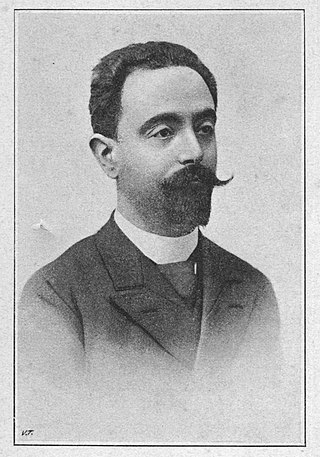
Carlo Munier (1858–1911) was an Italian musician who advocated for the mandolin's acknowledgement among as an instrument of classical music and focused on "raising and ennobling the mandolin and plectrum instruments". He wanted "great masters" to consider the instrument and raise it above the level of "dilettantes and street players" where it had been stuck for centuries. He expected that the mandolin and guitar would be taught in serious orchestral music schools and incorporated into the orchestra. A composer of more than 350 works for the mandolin, he led the mandolin orchestra Reale circolo mandolinisti Regina Margherita named for its patron Margherita of Savoy and gave the queen instruction on the mandolin. As a teacher, he wrote Scuola del mandolino: metodo completo per mandolino, published in 1895.
Giovanni Hoffmann was a composer and mandolinist who dwelled in Vienna, c. 1800, and has works preserved in the Austrian Gesellschaft der Musikfreunde archives in Vienna. Konrad Wölki said that he produced an "extensive creative output," for mandolin with other instruments, to include duets, a concerto, "quartets, divertimenti, sonatas and further works in different forms."
Dorina Frati is an Italian classical mandolin player. She performs regularly with European orchestras such as The Philharmonic of La Scala, the National Academy of Santa Cecilia, the National Orchestra of RAI, the Chamber Orchestra of Mantua and the Philharmonic of Rome. She completed her studies with Giuseppe Anedda, graduating from the Pollini Conservatory of Padua, Italy.

Pietro Armanini was an Italian mandolin virtuoso who was born in 1844 and died on 8 September 1895 in Bordeaux, France. As a professor at La Scala, he was one of the most famous exponents of the Milanese mandolin and the first to bring his instrument professionally before the English public.
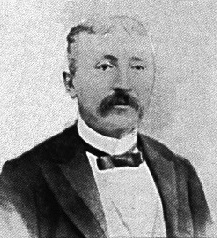
Giuseppe Bellenghi was a virtuoso violoncellist and mandolinist, and composer. He was remembered in 1914 as "a devoted champion of the mandolin."

Giuseppe Branzoli was a violinist, mandolinist, composer, author, educator at the Liceo Musicale di St. Cecilia in Rome, and the founder of the periodical IL mandolin Romano. His compositions were for violin, mandolin, flute and cello, as well as church music.
Giovanni Fouchetti published one of the earliest method books for the mandolin, c. 1771. According to Philip J. Bone, Fouchetti was also known as Fouquet, and he lived in Paris during the 18th Century. He was a professor there in 1788. He is also credited with creating a Parisian school of mandolinists, along with Eduardo Mezzacapo, Gabriele Leone, and Gervasio.
Belisario Mattera was an Italian musician and mandolin virtuoso who is recorded as the first mandolinist to give instruction on his instrument to the Princess Princess Margherita of Savoy, was the Queen consort of the Kingdom of Italy during the reign (1878–1900) of her husband, Umberto of the Royal family of Italy. For a period of from ten to fifteen years in the nineteenth century the nobility and aristocracy of the country followed the example of their Sovereign, and the mandolin enjoyed great favour amongst the wealthy classes.
Carmine de Laurentiis was a 19th-century Italian mandolinist, musical educator, author and composer who taught mandolin and guitar in Naples. His only well-known student was Carlo Munier. He wrote a mandolin method, Metodo per Mandolino, that was published in Milan in 1874, reported the following year in the Musical World. The article mentioning Laurentiis' method talked about the decline of the mandolin, calling the mandolin "entirely out of fashion."

Giuseppe Anneda was an Italian mandolin virtuoso who helped the mandolin gain more importance in the classical music world in the 20th Century. He performed with his instrument in concert halls around the world, including some where mandolin "had never entered", and taught at the Conservatory Pollini of Padua He also was able to gain access to manuscripts in museums, rediscovering works by Vivaldi, Pergolesi, Beethoven and many others.
Ugo Orlandi is a musicologist, a specialist in the history of music, a university professor and internationally renowned mandolinist virtuoso. Among worldwide musicians, professional classical musicians are a small group; among them is an even smaller group of classical mandolinists. Among members of this group, Ugo Orlandi is considered "distinguished." Music historian Paul Sparks called him "a leading figure in the rehabilitation of the eighteenth-century mandolin repertoire, having recorded many concertos from this period."

Pasquale Vinaccia was an Italian luthier, appointed instrument-maker for the Queen of Italy, and maternal grandfather to Carlo Munier. In 1835 he improved the mandolin, creating a version of the instrument that used steel wires for strings, known today as the "Neapolitan Mandolin." His use of steel strings has become the dominant way of stringing mandolins.
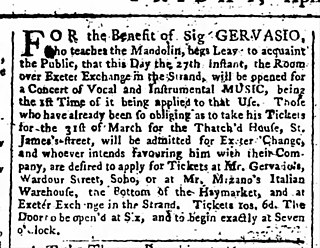
Giovanni Battista Gervasio was an Italian musician and composer. Born in Naples he was one of the first generation of virtuoso-mandolinists who left Italy and played the mandolin in Europe in the 18th century. He was a composer for the mandolin and his works can be found scattered in 18th century collections such as the Gimo music collection and the Bibliothèque Nationale de France. He also wrote a mandolin method Methode facile pour apprendre a quatre cordes, instrument pour les dames, published in Paris in 1767. He performed in London 1768 and in Frankfurt-on-the-Main on December 10, 1777, and the Concert Spirituel in Paris on December 24, 1784. He advertised in 1785 that he was master of singing and mandolin to Her Royal Highess, the Princess of Prussia. A work of music addressed to her exists today in the Bibliothèque Nationale de France.
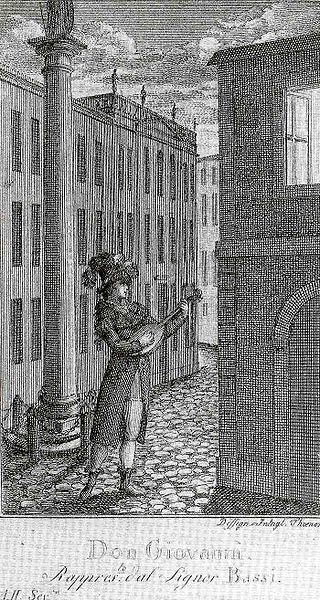
The mandolin is a modern member of the lute family, dating back to Italy in the 18th century. The instrument was played across Europe but then disappeared after the Napoleonic Wars. Credit for creating the modern bowlback version of the instrument goes to the Vinaccia family of Naples. The deep bowled mandolin, especially the Neapolitan form, became common in the 19th century, following the appearance of an international hit, the Spanish Students. They toured Europe and America, and their performances created a stir that helped the mandolin to become widely popular.
